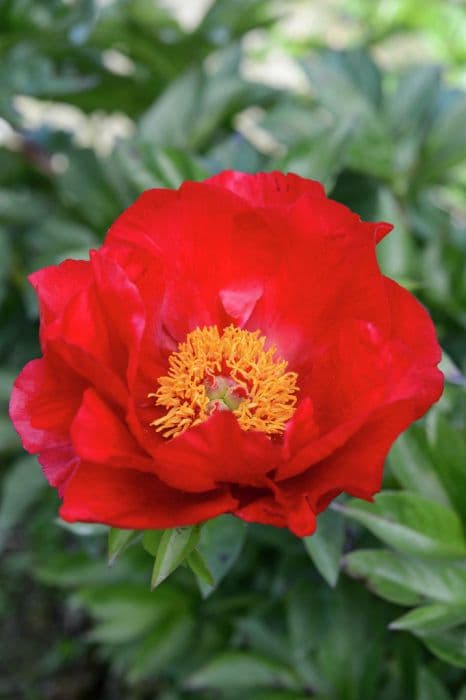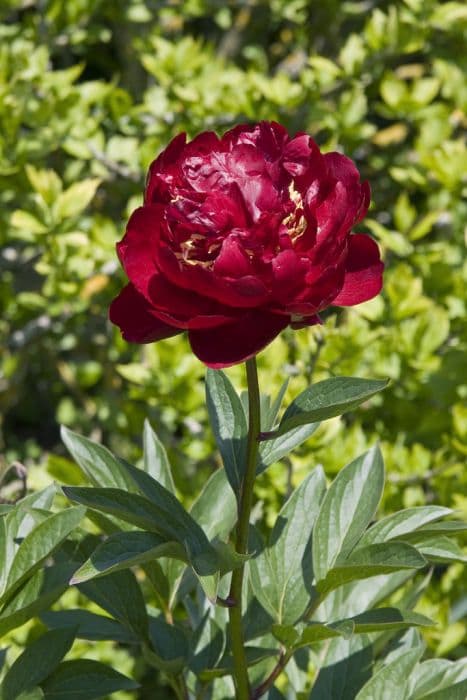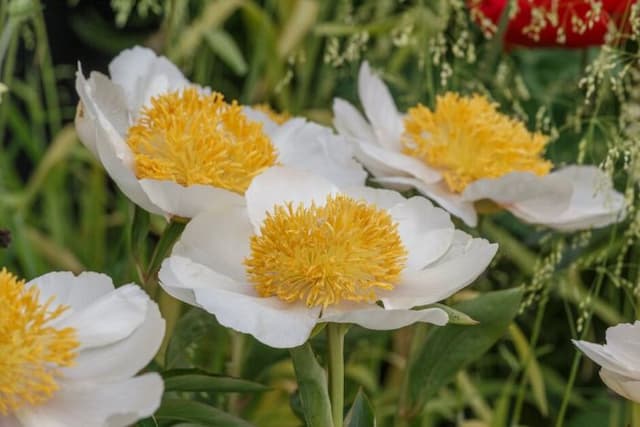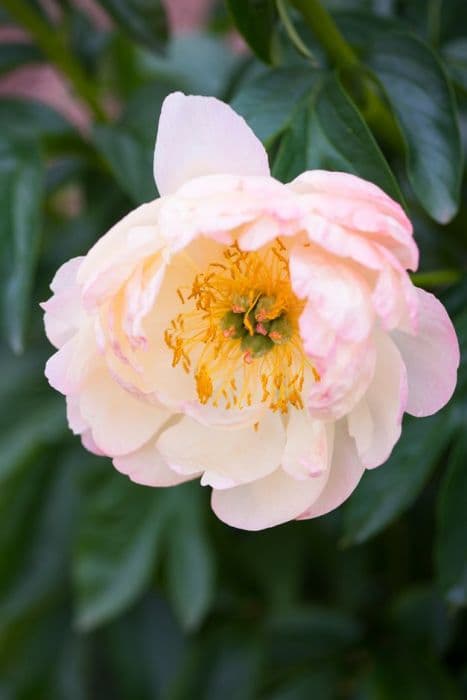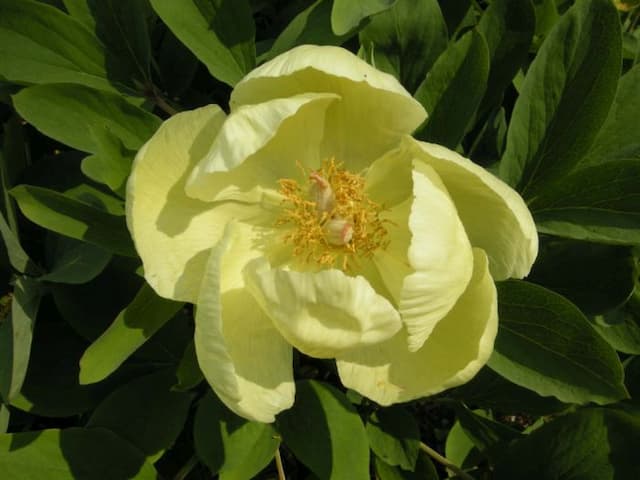Veitch's peony Paeonia anomala subsp. veitchii

ABOUT
The common name for Paeonia anomala subsp. veitchii is Veitch's peony. This plant showcases beautiful, deeply lobed leaves that are often dark green, providing a striking backdrop for its flowers. These blooms are particularly showy, with a stunning and vibrant pink hue that can vary from soft to a more intense shade. The flowers are generally large and bowl-shaped, with a lush, full appearance thanks to a multitude of delicate petals. At the center of each flower, a cluster of contrasting yellow stamens adds an eye-catching pop of color, making the bloom even more attractive. The flowers emit a pleasant fragrance, which makes them even more appealing. The plant typically blooms in spring or early summer, providing a colorful display in the garden. Its overall appearance is one of elegance and traditional garden beauty, often attracting garden enthusiasts and pollinators like bees to the area.
About this plant
 Names
NamesFamily
Paeoniaceae
Synonyms
Veitch's Peony
Common names
Paeonia veitchii, Paeonia Woodland.
 Toxicity
ToxicityTo humans
Peony, particularly Paeonia anomala subsp. veitchii, is not commonly listed as toxic to humans. Most peonies are considered non-toxic, but like many plants, they can cause mild gastrointestinal upset if ingested in large quantities. Symptoms could include nausea, vomiting, or diarrhea. Contact with the skin can sometimes cause irritation or a rash in sensitive individuals. It is generally recommended to avoid ingesting parts of ornamental plants due to the uncertain effects they may have.
To pets
Peony, specifically Paeonia anomala subsp. veitchii, is considered to be toxic to pets, including cats and dogs. If a pet ingests peonies, symptoms of poisoning could include vomiting, diarrhea, and drooling. In some cases, pets might also experience depression. It is advisable to keep pets away from peonies and to seek veterinary care if you suspect your pet has ingested part of a peony plant.
 Characteristics
CharacteristicsLife cycle
Perennials
Foliage type
Deciduous
Color of leaves
Green
Flower color
Pink
Height
2 feet [61 cm]
Spread
2 feet [61 cm]
Plant type
Herb
Hardiness zones
4
Native area
China
Benefits
 General Benefits
General Benefits- Aesthetic Value: The peony Anomala offers vibrant colors and an impressive blossom size, contributing to garden visual interest and appeal.
- Attracts Pollinators: This variety of peony can attract bees and butterflies, which are essential for pollination of many plants in the garden ecosystem.
- Longevity: Peonies are known for being long-lived perennials, which can provide beauty for many years with proper care.
- Seasonal Interest: Their blooming season in spring adds a timely burst of color after long winter months.
- Cultural Significance: Peonies have been celebrated in art and culture, especially in Asia, imbuing a garden with traditional floral symbolism and historical significance.
- Low Maintenance: Once established, peonies require minimal maintenance except for occasional watering and deadheading.
 Medical Properties
Medical Properties- Anti-inflammatory: The root and bark of Paeonia anomala subsp. veitchii may contain compounds that reduce inflammation.
- Analgesic: There might be components that act as pain relievers.
- Antispasmodic: Compounds in the plant could help to relieve spasms in the muscles.
- Immunomodulatory: The plant may influence immune system function.
 Air-purifying Qualities
Air-purifying QualitiesThis plant is not specifically known for air purifying qualities.
 Other Uses
Other Uses- Ornamental purposes: Paeonia anomala subsp. veitchii, commonly known as Veitch's peony, is often used for ornamental purposes in gardens and landscaping projects due to its attractive blooms and foliage.
- Cut flowers: The flowers of Veitch's peony are popular for use in floral arrangements, where they provide a lush, colorful display with their vibrant petals.
- Natural dye: The petals and other parts of the Veitch's peony can be used to make natural dyes for coloring fabrics, yarns, and other materials.
- Cultural significance: In some cultures, Veitch's peony may be used in traditional ceremonies or celebrations due to its symbolic meanings such as prosperity and romance.
- Garden borders: The plant can be used to create beautiful garden borders, lending a structured yet soft appearance to garden edges.
- Ground cover: When planted densely, Veitch's peony can provide effective ground cover, reducing weed growth due to shade provided by its foliage.
- Photography: The stunning blooms of the Veitch's peony make it a popular subject for photographers and artists seeking to capture its beauty.
- Companion planting: Peonies are sometimes planted among vegetables to help deter certain pests, taking advantage of companion planting strategies.
- Fragrance extraction: Although more common in other varieties, the fragrance of Veitch's peony flowers could potentially be used in the production of perfumes and scented oils.
- Horticultural education: Veitch's peony may be used in educational settings such as botanical gardens to teach about plant biology, horticulture, and taxonomy.
Interesting Facts
 Feng Shui
Feng ShuiThe Peony is not used in Feng Shui practice.
 Zodiac Sign Compitability
Zodiac Sign CompitabilityThe Peony is not used in astrology practice.
 Plant Symbolism
Plant Symbolism- Prosperity: Peonies are often associated with wealth and good fortune, making them symbols of prosperity.
- Beauty: With their lush, full blooms, peonies represent ideal beauty in various cultures.
- Romantic Love: Known for their romantic overtones, peonies are commonly used in wedding bouquets and are symbols of love and affection.
- Good Luck: Carrying the connotation of luck, peonies are thought to bring good luck and positive outcomes.
- Nobility: In ancient times, peonies were often reserved for the nobility due to their grand appearance, symbolizing regal elegance.
- Compassion: Peonies can also suggest a sense of compassion and empathy, reflecting the gentle nature of the bloom.
- Honor: Their robust nature and association with wealth and status also lend peonies to be emblems of honor and high esteem.
 Water
WaterVeitch's peony requires consistent moisture during the spring and early summer growing period, with reduced watering as it goes dormant in late summer. Water thoroughly once a week, applying about one gallon of water per plant to ensure the soil is moist but not waterlogged. During hot and dry spells, you may need to water twice a week, but always check the soil moisture level first, as overwatering can lead to root rot. In the fall and winter, watering can be significantly reduced as the plant requires a period of dry dormancy.
 Light
LightVeitch's peony thrives in full sun to partial shade, with at least six hours of sunlight per day being ideal. The best spot for planting is one where it receives morning sun and afternoon shade, particularly in hotter climates, as this can help prevent the flowers from fading too quickly.
 Temperature
TemperatureVeitch's peony can tolerate a wide range of temperatures, but it grows best in areas where the temperature ranges between 65°F and 75°F during the growing season. It can survive winter temperatures down to -20°F and requires a period of cold dormancy to bloom successfully. Maintaining a temperature above freezing, yet cool during its dormant season, encourages healthy growth for the following spring.
 Pruning
PruningPrune Veitch's peony after it has finished flowering, typically in late summer, to remove spent blooms and any dead or diseased foliage. This will maintain airflow and plant health, reducing the risk of fungal diseases. The best time for a major pruning is in fall, when you can cut back the stems to ground level as the plant goes into dormancy.
 Cleaning
CleaningAs needed
 Soil
SoilThe best soil mix for the Veitch's peony should be well-draining with plenty of organic matter, ideally a loamy soil enriched with compost. The pH should be neutral to slightly alkaline, ranging from 6.5 to 7.5 for optimal growth.
 Repotting
RepottingVeitch's peony should be repotted every three to four years as it is a relatively slow-growing plant. It is best to repot after flowering when the plant is dormant.
 Humidity & Misting
Humidity & MistingVeitch's peony thrives in moderate humidity levels but does not require special humidity considerations as long as the soil moisture is maintained appropriately and it is not in an arid environment.
 Suitable locations
Suitable locationsIndoor
Use well-draining soil, bright indirect light, and cool temperatures.
Outdoor
Plant in spring, full sun/part shade, well-draining fertile soil.
Hardiness zone
3-7 USDA
 Life cycle
Life cycleThe life cycle of Paeonia anomala subsp. veitchii, commonly known as Veitch's peony, begins with seed germination, which occurs in spring and may require cold stratification to break dormancy. The seedling then develops into a juvenile plant, producing a small rosette of leaves near the soil surface. As the plant matures, it forms an herbaceous perennial structure with woody roots and multiple stems, which dies back to ground level each winter. Over a few years, the plant will reach reproductive maturity, at which point it will produce large, showy flowers typically in late spring or early summer. After pollination, often by insects, the flowers develop into follicles containing seeds. The plant will enter a period of dormancy in the autumn, when foliage dies back, to reemerge the following spring, completing its annual life cycle.
 Propogation
PropogationPropogation time
Spring-Early Summer
The most popular method of propagation for Paeonia anomala subsp. veitchii, commonly known as Veitch's peony, is by division. Division should be carried out in the autumn after the foliage has died back. This involves carefully digging up an established plant and gently separating the root ball into smaller sections. Each section must have at least one eye, which is a potential growth point for next season's stem. These divisions can then be replanted at a spacing of about three feet (approximately 91 centimeters) apart to give each new plant enough room to grow. Care should be taken to plant the eyes no more than two inches (about 5 centimeters) deep to ensure successful sprouting in the spring.
